Posts Tagged by jillian ferraiuolo
Snowshoes: 2024 IMLS Feature
As we come to the end of our 2022-2024 IMLS (Institute of Museum and Library Services) grant project, the Conservation staff are showcasing standout objects recently treated. During the two-year project we have conserved and relocated 2,106 objects, and created fully digital catalog records for 815 of these. The following blog highlights the snowshoes that made their way through this grant, now made accessible to the public via The Henry Ford’s Digital Collections.
Snowshoes have a long history in North America. Indigenous peoples invented the form using thin strips of collagenous material (sinew or treated hide) and bent wood. The woven strips created a netting used for walking on snow. In fact, using snowshoes helped Indigenous peoples in snowy areas thrive during wintertime. The shoes facilitated trade, hunting, trapping, and self-defense. You can read more about the advantages of Indigenous snowshoe knowledge in Thomas M. Wickman’s book, Snowshoe Country: An Environmental and Cultural History of Winter in the Early American Northeast (2018).
Wickman focuses on the Wabanaki, including Mi’kmaq, Maliseet, Passamaquoddy, and Penobscot peoples, in northern New England. The Wabanaki held advantage in the area during the 1600s, but by the early 1700s, British colonizers co-opted Indigenous tactics, including snowshoes, and launched winter offensives with the goal of eliminating their Indigenous opponents. Snowshoes then became a tool that British colonizers used for daily winter transport.
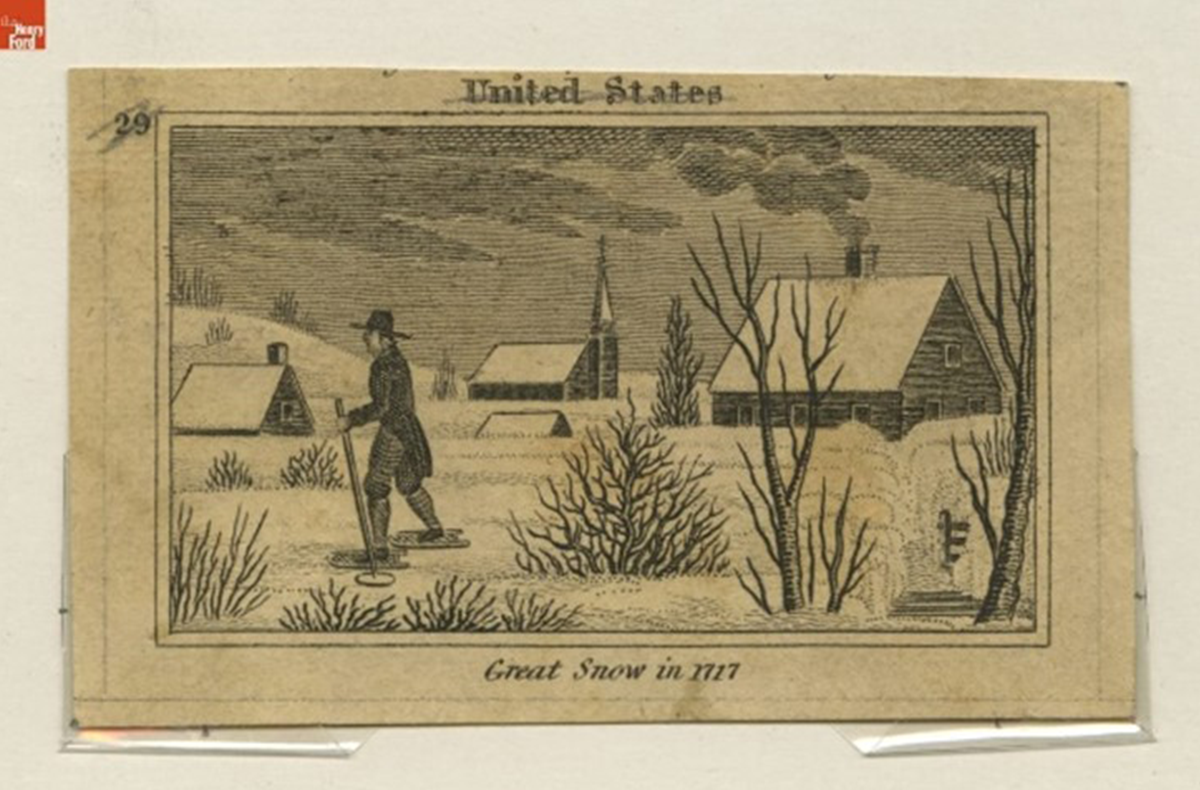
Copperplate engraving made around 1820, "Great Snow in 1717" / THF118620
A description of the “Great Snow Storm” of 1717, included in Historical Scenes in the United States (1827), described the snow as being so deep that “people stepped out of their chamber-windows on snow shoes.” The author, John W. Barber, mentions consequences of the 1717 snow, a “terrible tempest” that trapped New Englanders in upward of 15 feet of snow accumulated over several storms in late February and early March. The rather bucolic illustration does not convey the tragedy of the weather event. The 1891 book Historic Storms of New England does a better job. Author Sidney Perley puts the storm into context in his chapter, “The Winter of 1716-1717,” including the loss of livestock and humans. He also provides detail about those colonists who donned snowshoes, including mail carriers and residents who relied on the shoes to tend to livestock or assist neighbors, and sometimes to visit sweethearts.
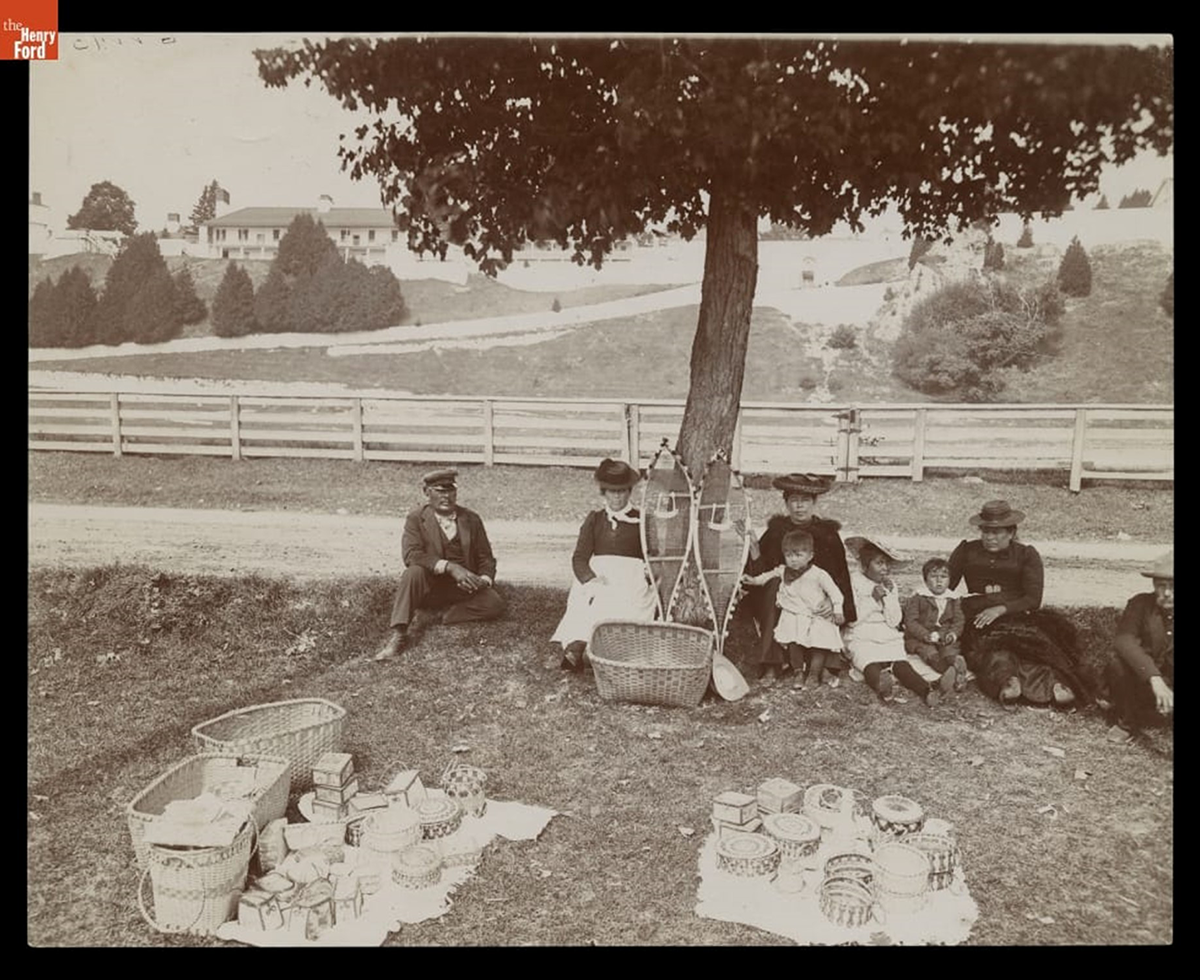
Native American Basket Market, Ojibwa Tribe, Mackinac Island, Michigan, September 1904 / THF118996
Indigenous knowledge remained essential to snowshoe construction. A photograph shows Ojibwa people selling baskets, and in the background, a pair of snowshoes leaning against a tree. The snowshoes treated during the IMLS grant project lack the decorative tufts of either dyed moose hair or wool visible on the Ojibwa snowshoes, but the intact webbing, carefully conserved, still indicates the craftsmanship evident in each shoe.
Some of the snowshoes in The Henry Ford’s collections still have their leather ankle loops and toe thongs intact. These details secured the toe to the shoe, leaving the heel free to lift the shoe and step forward with each stride.
The following images show the work of conservation, and the photography that was used to document our process. We are pleased to be able to share these remarkable artifacts via THF’s Digital Collections.
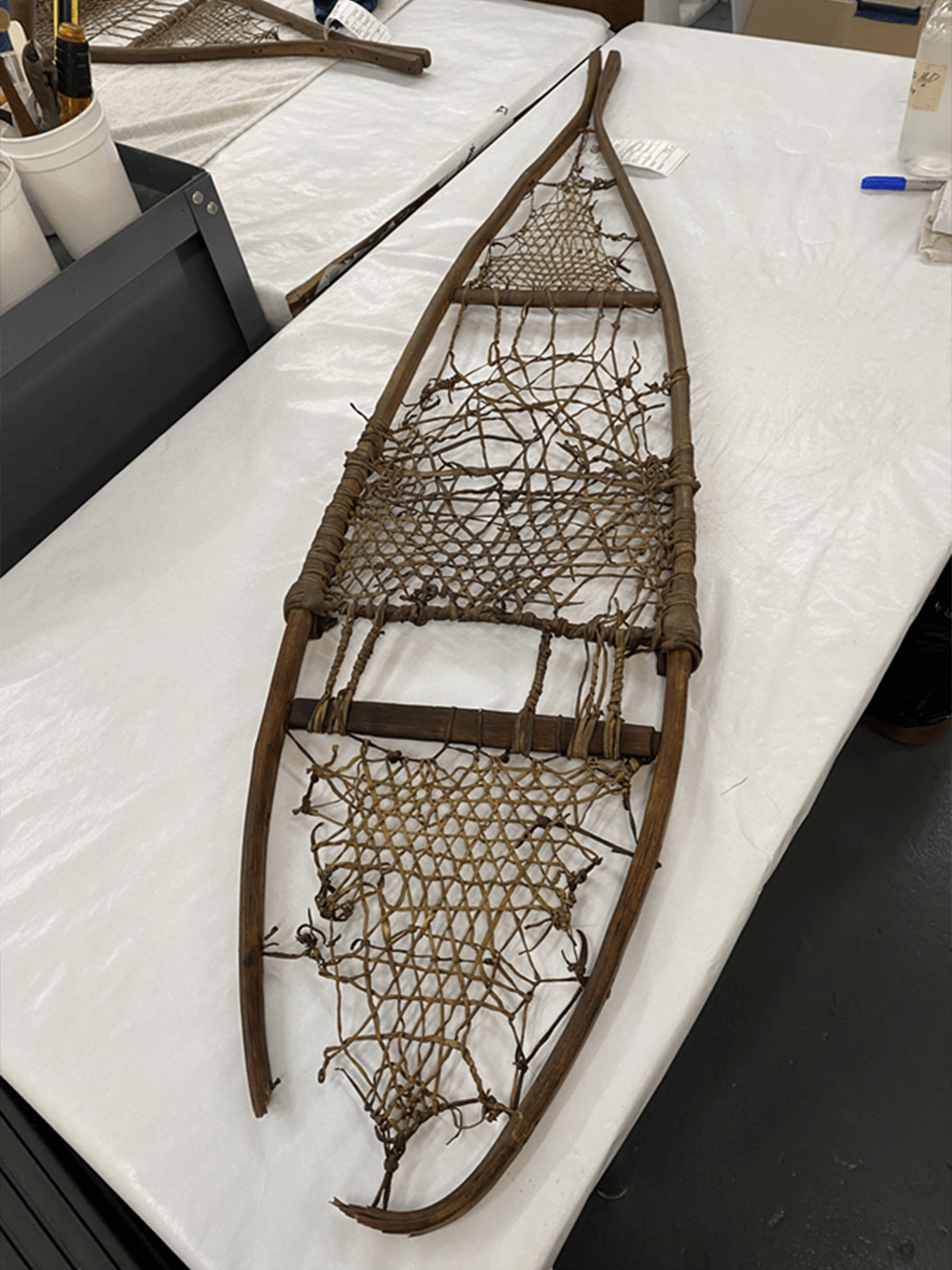
One shoe of a pair of snowshoes needed stabilization before proper handling. A section of the wood frame was missing, leaving sharp pieces of wood sticking out. The dowels keeping the tail together had split, causing more tension on the weakened rawhide webbing. / Images by Jeeeun Sims (Jee Eun Lim)
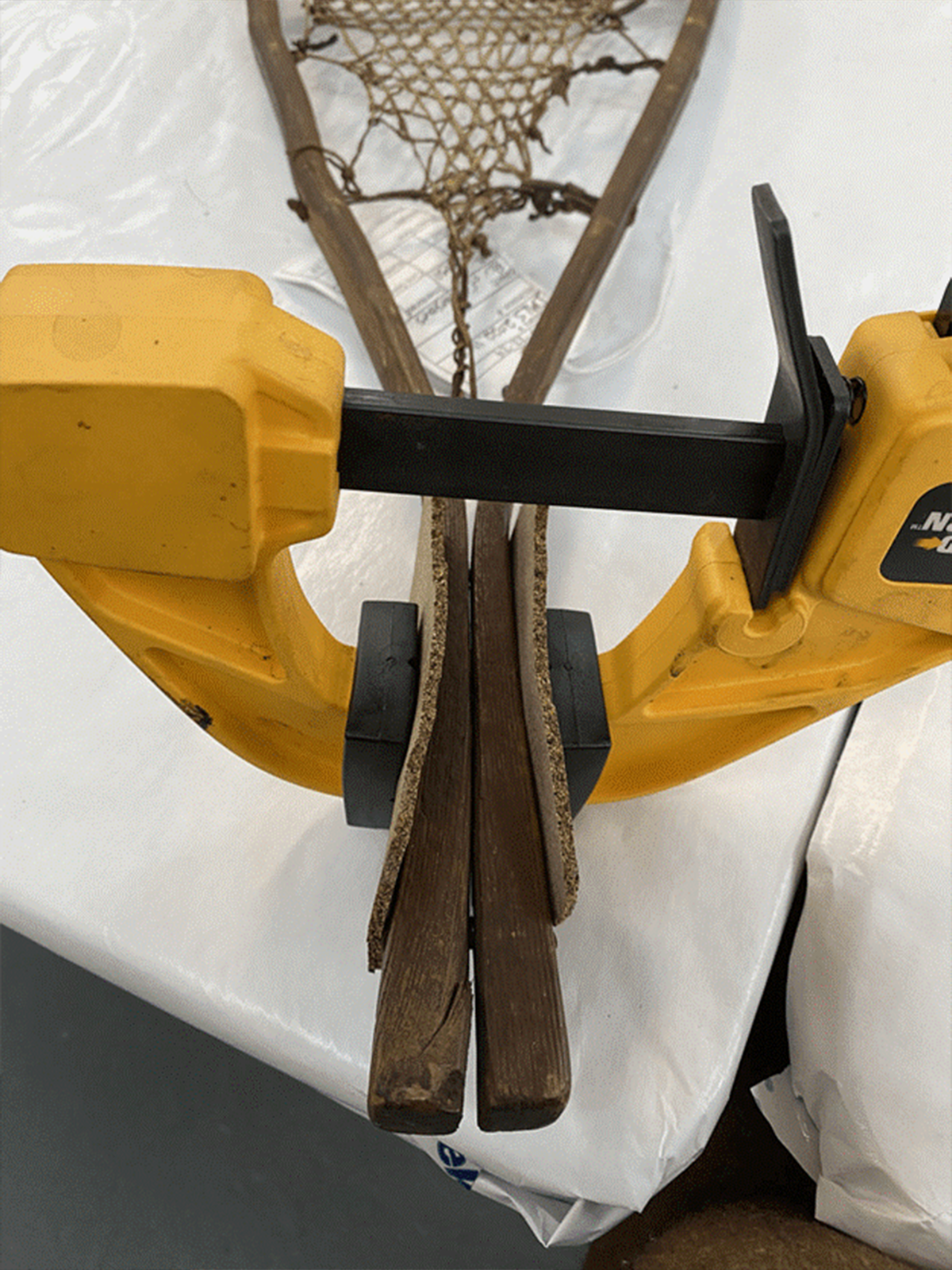
The tail was stabilized with painted wooden dowels inserted between the gaps that were secured with wood glue. The large loss to the wood frame was filled with a wood putty that was levelled, scored with a dental pick to create the wood grain, and painted to match the rest of the wood. / Images by Jeeeun Sims (Jee Eun Lim)
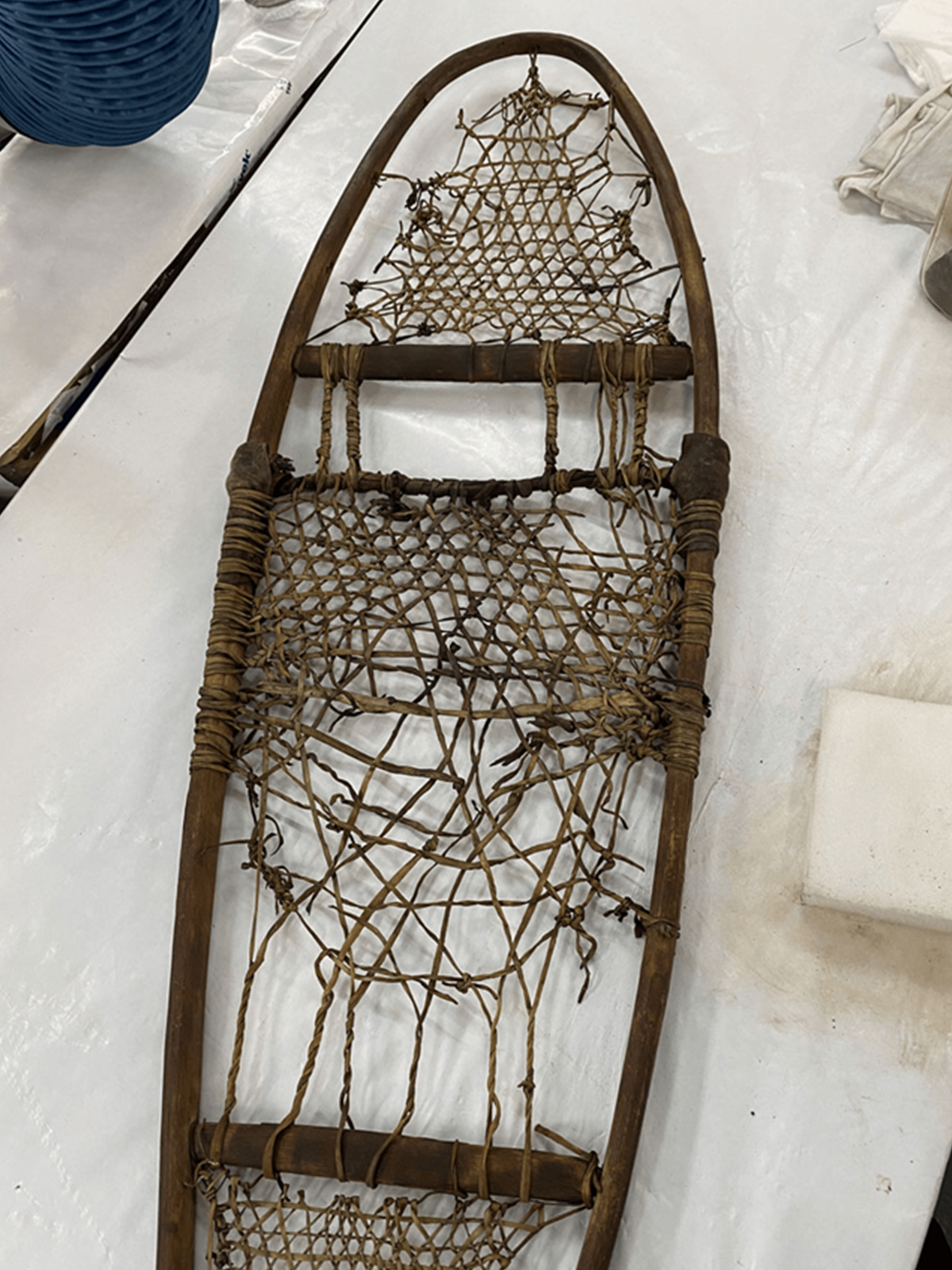
The rawhide was then cleaned with a mild detergent and distilled water with a stiff brush to remove as much dirt as possible. The rawhide webbing is rather sturdy, even where it had detached from the wooden frame, and was not in need of reattachment at this time. / Images by Jeeeun Sims (Jee Eun Lim)
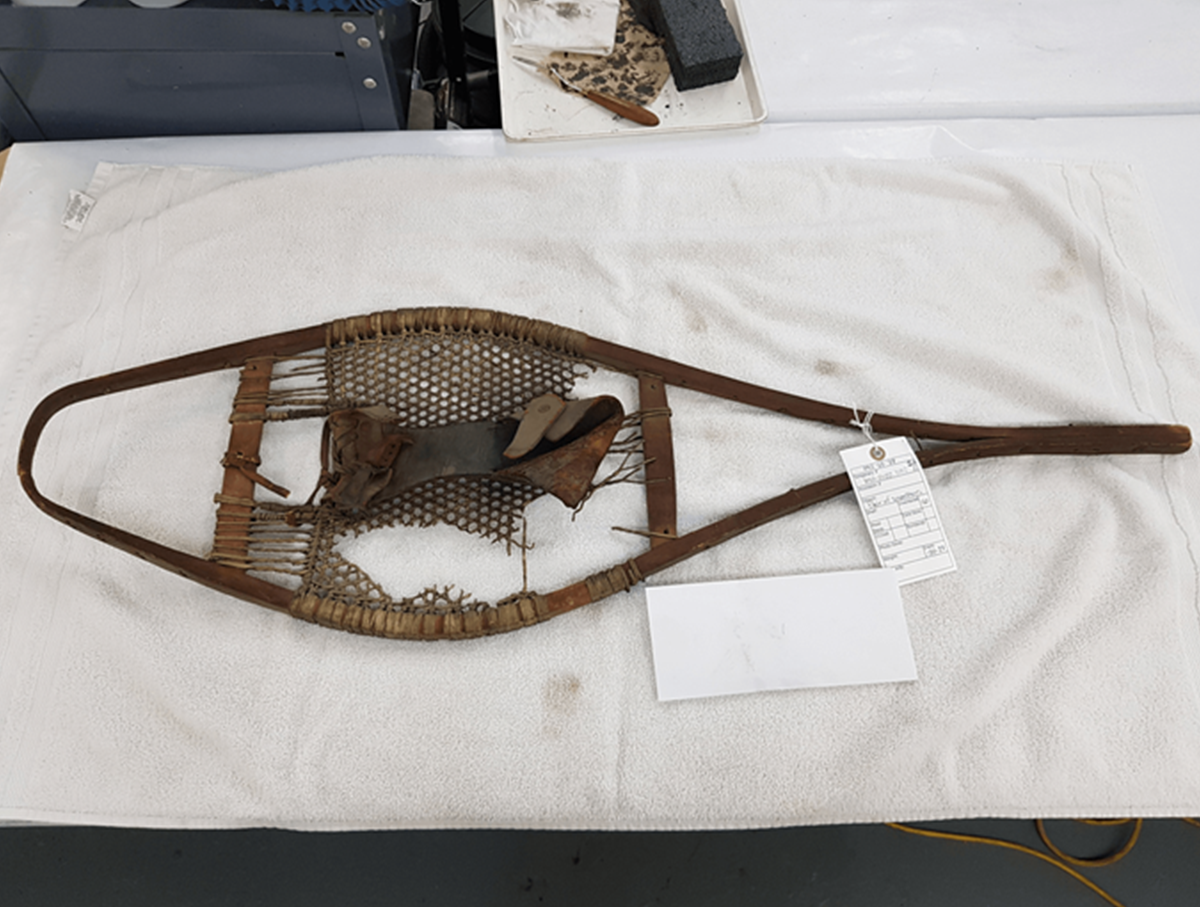
Another pair of snowshoes in a different shape from the previous pair has leather shoe holders attached to the mesh component made of rawhide. One-fourth of the mesh is missing, while the rest of the mesh was stained by dirt and dust. The overall surface of the leather was fragile, cracked, missing, and broken in some areas. A leather strap to hold the toes was split and separated from the object. / Images by Jeeeun Sims (Jee Eun Lim)
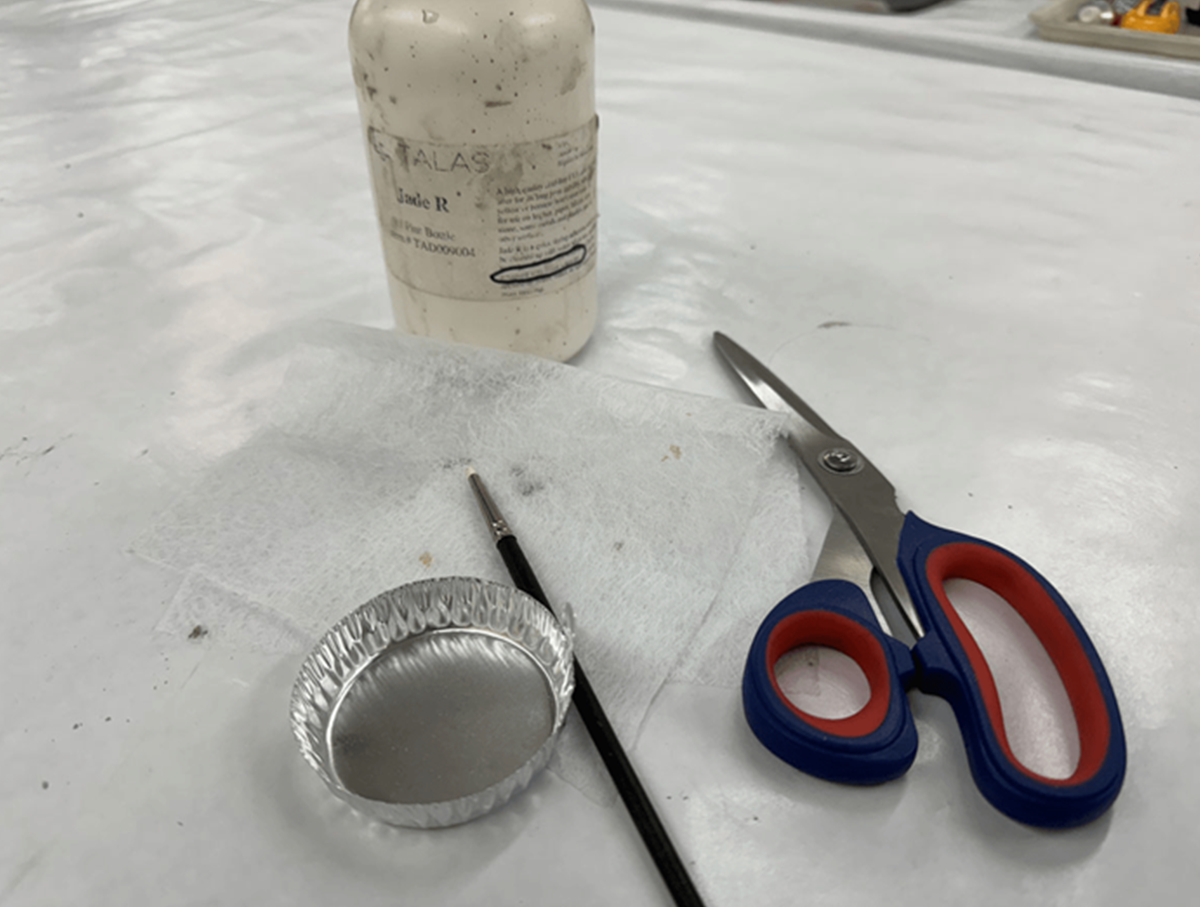
The leather was consolidated with Jade R adhesive and Japanese tissue attached to the reverse side of broken leather areas after cleaning with distilled water. The split leather strap was also reattached in the original position by the same restoration method. The restored areas by Japanese tissue were painted to match the rest of the leather. The rawhide was cleaned with the same method as described with the previous snowshoes. / Images by Jeeeun Sims (Jee Eun Lim)
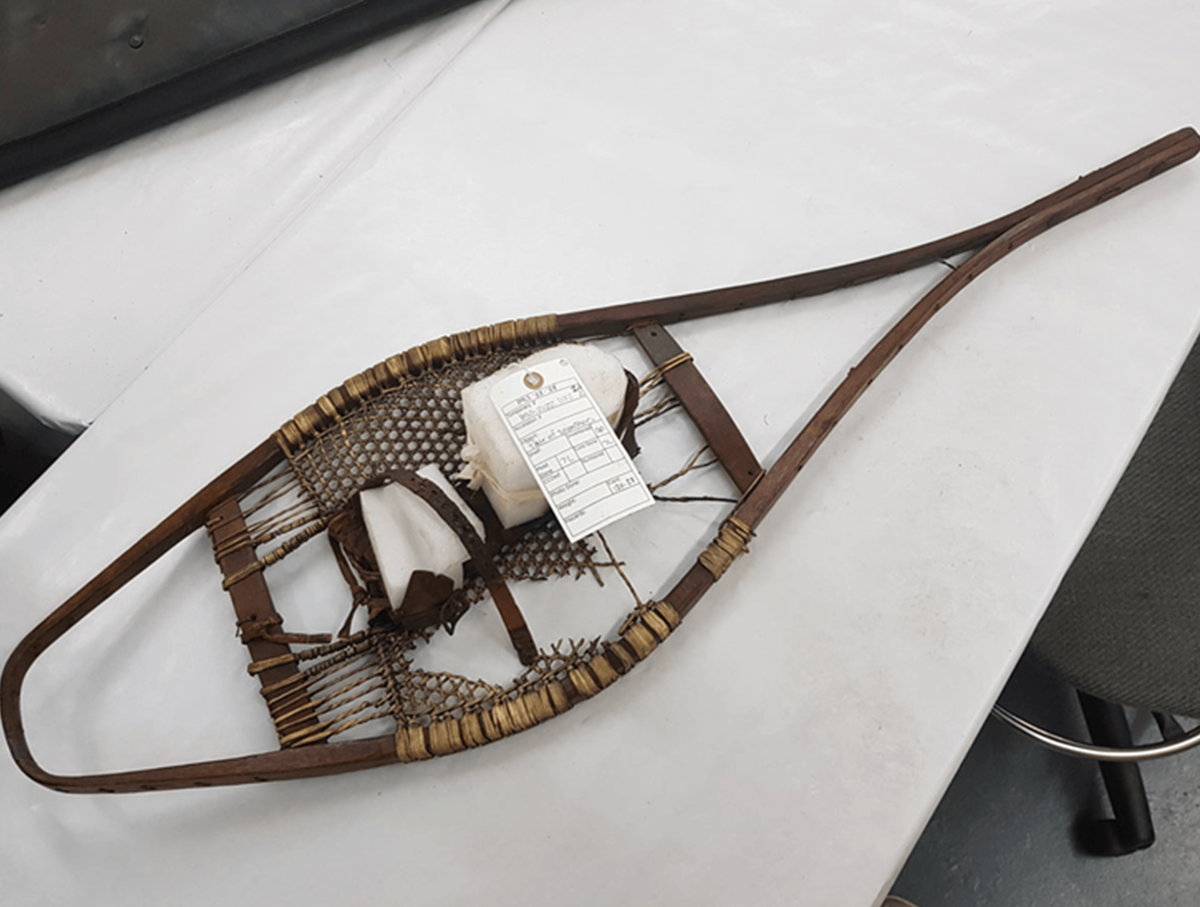
The leather shoe holder is held in place with a foam support to keep the shape and avoid further physical damage. Oil-based gel stain mixed with nutmeg and antique walnut color was applied on the wood surface of the object to match the rest of the color of the wood. / Images by Jeeeun Sims (Jee Eun Lim)
Thanks to the work of the IMLS team, the care and conservation of these organic artifacts is complete. In the photo studio, the snowshoes presented even more complexities.
They proved to be one of the trickiest (and most delicate) objects photographed throughout the IMLS grant project. Senior photographer and studio manager, Jillian Ferraiuolo, outlines below how the snowshoes needed to be handled carefully to be properly photographed.
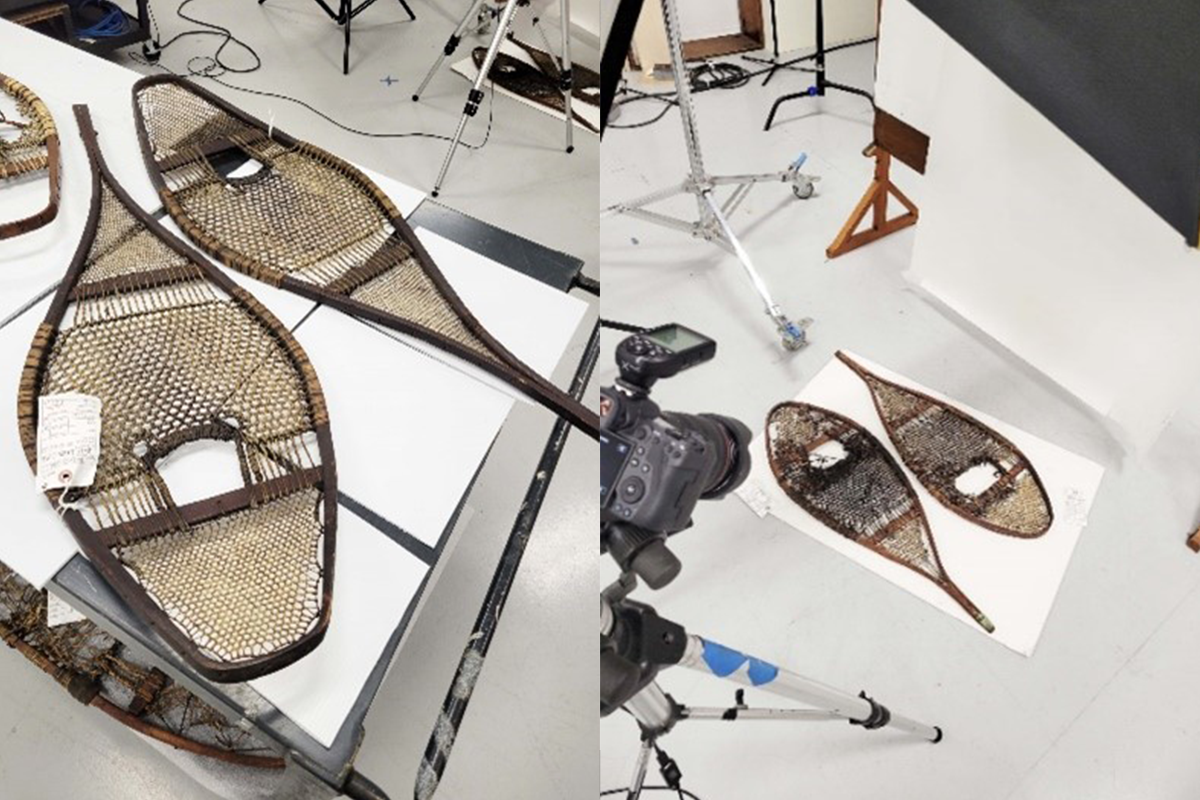
Snowshoes set up for photography / Image by Jillian Ferraiuolo
Because they are so large, the snowshoes were photographed on the ground, with white boards placed underneath to protect them from the floor. A white background also makes it easier to clean the background during the editing phase and remove anything that’s not a part of the object.
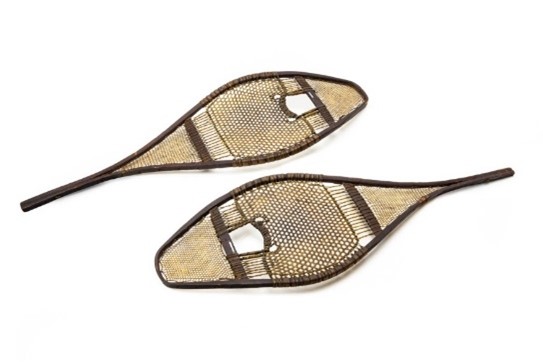
Object 2022.0.22.646 / THF800530
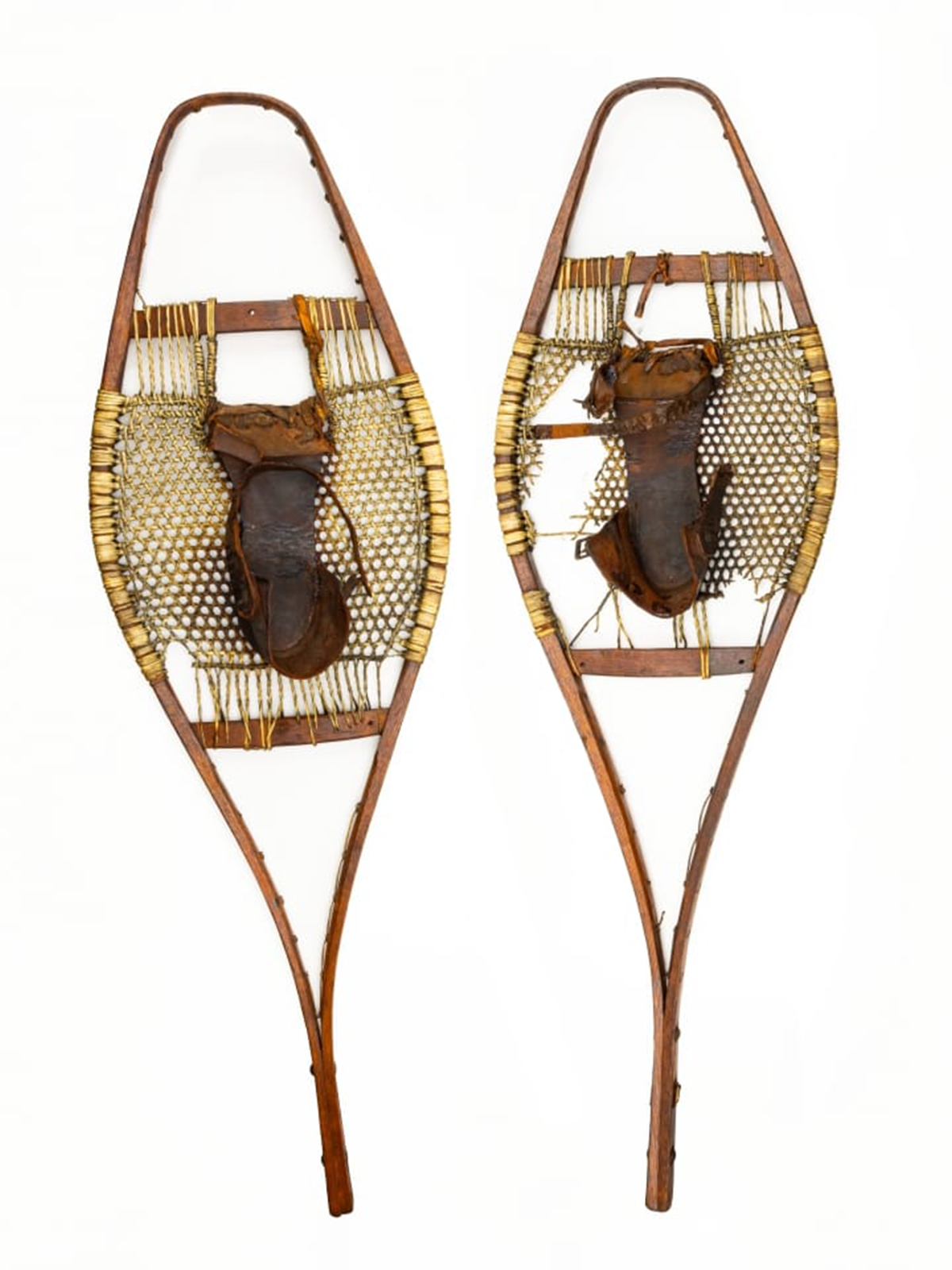
Object 2022.0.22.645 / THF800534
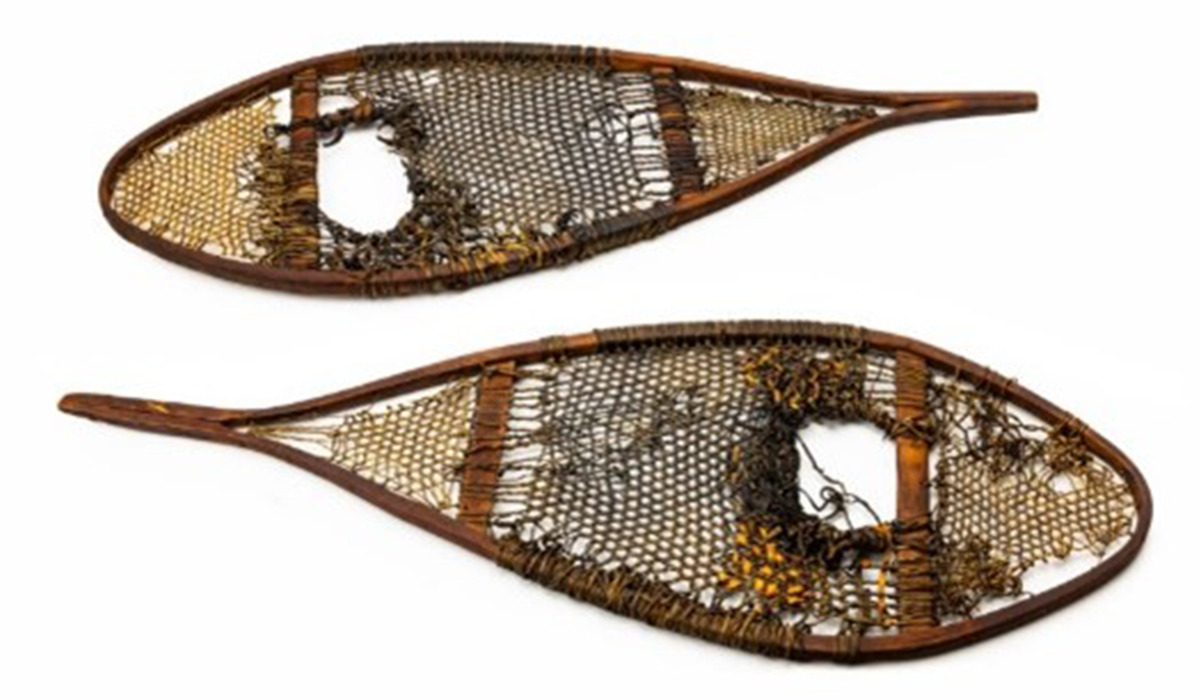
Object 2022.0.22.644 / THF800535
Photographing the snowshoes was one of the final steps towards getting these important objects added to THF’s Digital Collections webpage. Thanks to IMLS funding, these and more artifacts that tell agricultural and environmental histories have become more accessible.
This blog was written by Jeeeun Sims (Jee Eun Lim), IMLS project conservator; Jillian Ferraiuolo, senior photographer & sudio manager; and Debra A. Reid, curator, agriculture and the environment.
Marlene Gray, senior conservator; Julia Fahling, conservation specialist; Eleanor Glenn, former conservation specialist; Mary Fahey, chief conservator; and volunteers (Eric Bergmann, Maria Gramer, Frances McCans, and Larry McCans) assisted Jee throughout the two-year grant project.
How Do You Move a Photo Studio?
That is a very good question! While I don’t recommend moving from a larger space to a smaller one unless you have to (which we did), with time and effort, lots of help, and boxes, it can be done. Being photographers, it’s in our nature to document—well, everything—so come along on a Photo Studio–moving journey with me.
For almost 50 years, The Henry Ford’s Photo Studio has been located at the back of Henry Ford Museum of American Innovation—you may have walked past our windowed French doors on your way from Driven to Win: Racing in America towards the Highland Park engine. The Photo Studio, along with photographer Rudy Ruzicska and I, even made an appearance in Season Two of The Henry Ford’s Innovation Nation.
Continue Reading
Michigan, Dearborn, 21st century, 2020s, photography, Main Storage Building, by Jillian Ferraiuolo, #Behind The Scenes @ The Henry Ford
Photographing Artifacts in Our Main Storage Building
While we have a photo studio where we do most of our artifact photography using white backgrounds and strictly controlled lighting, many times we encounter things that are too big for this setting—for example, a car! In those cases, we need to take ourselves and our studio on the move, and our newest collections storage building, the Main Storage Building (MSB), gives us a perfect environment for that. While sometimes space can be an issue (there are only so many places you can store dozens of wagons and plows), we make the most of the room we have and get creative in the meantime.
For example, to photograph “The Busy World” automaton wagon, it first needed to be moved out of a row of wagons and into an open space to give us room to set up our lights and camera.
“The Busy World” automaton wagon in storage in MSB before photography. / Photo courtesy Jillian Ferraiuolo
The completed photograph of the automaton. / THF187282
Since the Unimate robot was featured in an episode of The Henry Ford’s Innovation Nation, we needed to capture new photographs of it for our Digital Collections before the episode aired. While we had a little more room to work when photographing the Unimate (this was before MSB was as full as it is today), we still benefitted from having the ability to set up all around it because it is extremely heavy and cannot be easily moved. We had to use the space around it to access both sides for our standard photography.
Photographing the Unimate. / Photo courtesy Jillian Ferraiuolo
Completed photo of the Unimate robot. / THF172780
It was a similar situation when we photographed the 1977 Ford Mustang II. Though now this area in MSB houses an array of agricultural equipment, such as plows and wagons, in 2018 we were able to use the open area to photograph the Mustang II for the first time so it could be viewed online.
Photographing the Mustang II. / Photo courtesy Jillian Ferraiuolo
Completed photo of the Mustang II. / THF173560
This next example shows a more current look at MSB in 2021. As you might be able to see, there are many more vehicles now occupying the large area where we shot the Unimate and Mustang II. So when we were tasked with the job of photographing a 1925 Yellow Cab, we were unable to circle around it and had to work with our collections management team to move the taxi for us as we documented it.
Photographing the 1925 Yellow Cab taxicab. / Photo courtesy Jillian Ferraiuolo
You can also see that we created our own white background around the cab with tall foamcore boards (a little thing that helps immensely with post-processing in Photoshop). But our “studio” was surrounded by another car to the right and a wagon to the left! All this careful maneuvering and setup was necessary to get the final image.
Final photograph of the 1925 Yellow Cab Taxicab. / THF188014
Looking at the completed image, you probably would never know what it looked like when we were photographing it out on the floor in MSB!
My final example, the Ford COVID-19 mobile testing van, was so tall that it almost reached the ceiling in the tallest room in MSB. Since it’s a full-sized van, it isn’t easy to move—especially inside a building. In case that isn’t enough, its current neighbors in storage happen to be a couple of large fire engines. Regardless, we got creative again and we were able to get photos of the van despite these challenges.
Photographing the Ford COVID-19 mobile testing van. / Photo courtesy Jillian Ferraiuolo
Completed photo of the COVID-19 mobile testing van. / THF188109
Besides being an invaluable space to store an extensive variety of precious artifacts from our collections, MSB also serves as a functional space for us to use as photographers—so we can digitize artifacts even if they’re larger than we can accommodate in our photo studio.
Jillian Ferraiuolo is Digital Imaging Specialist at The Henry Ford.
Main Storage Building, photography, photographs, digitization, collections care, by Jillian Ferraiuolo, #Behind The Scenes @ The Henry Ford
Behind the Scenes: Photographing the Interior of the Fair Lane Railroad Car
These days, most people may not be familiar with the interior of a rail car, let alone set foot inside one that is 100 years old. For those of you who have never been inside a railcar, it is very tight quarters—both for people and also for photography equipment and lights. So, when photographer Rudy Ruzicska and myself were tasked with getting new images of the interior of the 1921 Fair Lane, Henry Ford’s private railroad car (now located in the Railroads exhibit in Henry Ford Museum of American Innovation), we knew we were going to have to get creative—and close!
Photographer Rudy Ruzicska setting up lights for our first exterior shot of the railcar…
…and the final shot. / THF186261
We knew that this was going to be a challenge, but a fun one. The largest rooms were at the front and the back of the car, with narrow hallways and small bedrooms between—and even smaller bathrooms! We captured as many angles as we could within such small spaces.
Rudy again, setting up lights for our first interior shot of the lounge….
…one of the resulting shots…. / THF186262
…and another final shot. / THF186264
Digital Imaging Specialist Jillian Ferraiuolo (me!) setting up the shot of the hallway…
…and the final image. / THF186265
Jillian again, setting up the shot of the office…
…and the final image. / THF186266
For most photos, we use a Canon 5D Mark III camera tethered to a MacBook laptop. While we did use that camera for this photo shoot, we knew we would need something with a wider range to capture the small rooms. A fisheye lens is very convex, and because of that shape it allows the camera to capture a larger area. While these lenses are great, their downside is the distortion they create because of the curve of the glass. Since our job in the Photo Studio is, at the core, documentation, we want to show our artifacts exactly as they are, without that distortion, so to capture these small rooms we needed something more.
Our solution was to use another tool already in our toolbox, the Ricoh Theta 360 camera. This small camera is operated via cellphone and app and uses two fisheye lenses to capture a space. The app control allows us to preview the 360-degree image and remotely trigger the camera (so we can make sure we’re out of the shot). The app then stitches together the images to create a full 360-degree interactive image. This is how we were able to capture the interiors of the rooms completely, including the nooks and crannies of these small spaces where our Canon camera simply couldn’t reach.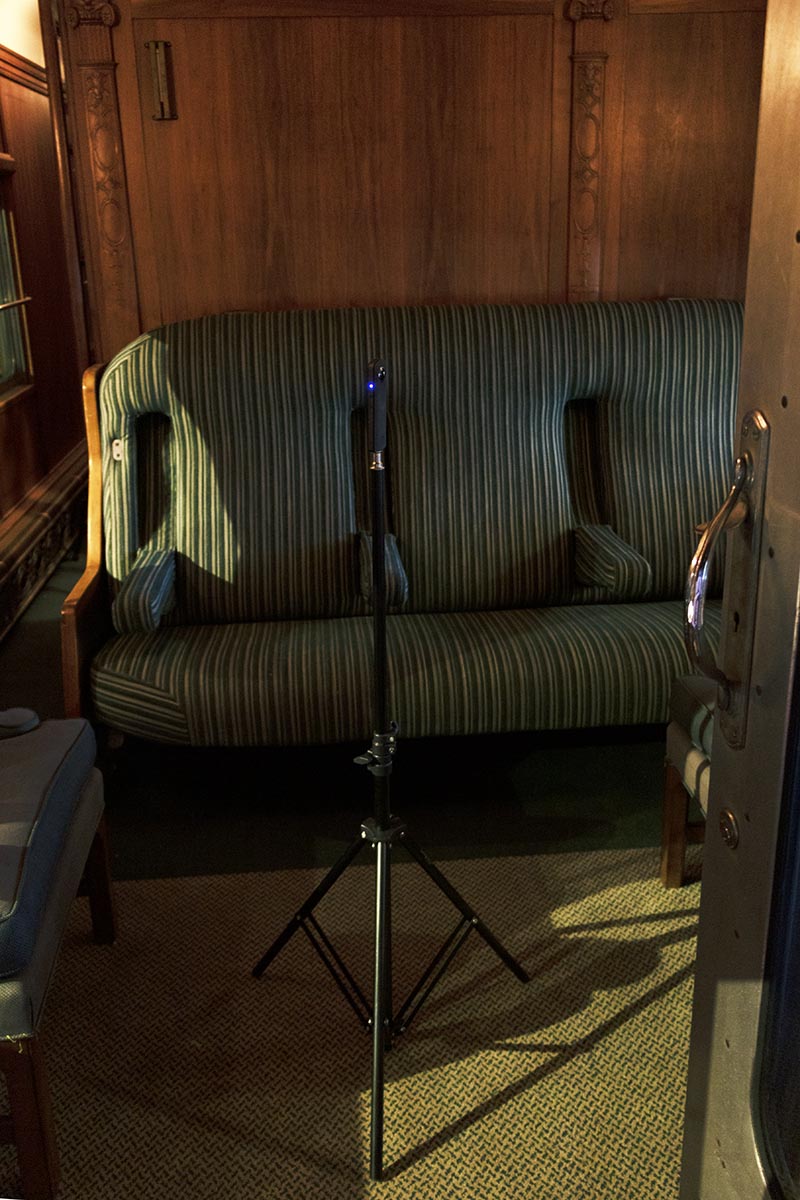
The Theta camera, mounted on a stand, ready to capture the interior of the lounge. See the 360-degree image (and the others we took) here!
We captured all of the rooms (and bathrooms!) this way, with the Theta, as well as with the Canon camera, to make sure everything was thoroughly documented. Though this certainly led us into a few tight spaces….

Jillian and Rudy doing their best to capture the very small main bathroom and shower off the Fair Lane’s main hallway…

…and the final images of the bathroom. / THF186274, THF186275
As photographers of the wide variety of artifacts at The Henry Ford, our job is certainly never boring, but when faced with unique requests like the Fair Lane, we get to have a little more fun than usual and really test the limits of our creativity and ingenuity.
I hope you enjoyed this behind-the-scenes look at how we photographed Henry Ford’s private railcar. Be sure to check out some of the new images on the artifact card below, or click through to our Digital Collections to explore all of the images and 360-degree interiors! And read more about the Fair Lane, its travels, and its history in celebration of its 100th birthday this year.
Continue Reading
digitization, digital collections, railroads, Henry Ford Museum, photographs, by Jillian Ferraiuolo, Fair Lane railcar, #Behind The Scenes @ The Henry Ford, photography
Photographing Large Artifacts on Location
My name is Jillian Ferraiuolo and I’m a Digital Imaging Specialist at The Henry Ford. In that role, I work with our institutional photographer in our Photo Studio, taking photographs of artifacts and preparing those for use in our Digital Collections.
This graphic shows where photography fits into The Henry Ford's overall digitization process.
Every once in a while, our job requires us to step out of the studio, equipment and all, and photograph artifacts on location. Whether it’s taking photos of cars in one of our storage buildings or taking photos in (or of!) one of the buildings in Greenfield Village, if it can’t fit inside the studio, then we pack up and go to it. For example, the geodesic truss pictured below is in storage, but we needed to photograph it. You can see from the photo below how large it is, so instead of trying to find some way to get it to the Photo Studio in the museum, we went to it.
Photography staff and volunteers shooting the geodesic truss on location at a storage building.
The finished product: Geodesic Dome Test Module, Designed by R. Buckminster Fuller, 1953. / THF166740
One of the biggest challenges for us when we shoot outside the studio is making the most of our time. Given how large our campus is, we try to be as efficient as possible while still creating the same shooting environment on location as we would in the studio, especially when it comes to lighting and image quality. Another challenge of location shoots is that they allow less freedom than being in the studio—some objects are in a specific spot and can’t be moved or adjusted. When we’re in the studio we can change angles, move lights, and make adjustments easily, but if we’re out photographing a train car, and need to capture a different view, we have to move around it—there’s no way it’s moving!
Another example of getting creative to photograph a lathe used by Henry Ford out at the Bagley Avenue Workshop in Greenfield Village.
While shooting out on location can be a challenge, it is also a nice change of pace and a nice change of scenery. It forces us to think outside the box and get creative with taking photos—especially when the shoot involves something outside the norm. Take, for example, quilts—since they’re so large, we have to get up much higher than they are so we can get an accurate photo of the entire quilt. (You can read more about our quilt photography process here.)
Getting ready to photograph quilts from the Highland Park Engine catwalk in Henry Ford Museum of American Innovation.
But whether we’re in the studio or not, we’re passionate about what we do, and we are ready to take on any challenge!
Continue Reading
by Jillian Ferraiuolo, #Behind The Scenes @ The Henry Ford, #digitization100K, digitization, photography
Photographing Glass
My name is Jillian Ferraiuolo and I’m a Digital Imaging Specialist at The Henry Ford. In that role, I work with our institutional photographer in our Photo Studio, taking photographs of artifacts and preparing those for use in our Digital Collections. Today I’m going to share a bit about the challenges of photographing glass artifacts.
This graphic shows where photography fits into The Henry Ford's overall digitization process.
If you haven’t had a chance to check out our extensive studio and art glass collection (whether in person in the Museum or Village glass galleries, or online), I recommend you do so! We have pieces that range from teapots and cups to whimsical studio glass sculptures. Photographing these beautiful pieces of glass provides unique challenges.
The first task is to figure out the angles to shoot. Many of these are works of art, so figuring out the “front” and the “back” is difficult. Take the piece below, "Bubble Boy" by Richard Marquis, for example. It’s hard to tell what the best angle would be, so we take our best guess, and take more than one photo if we need to! Most of the time, we’ll look for a defining feature: say, a handle, or an area of the design that is most appealing, and start there.

Two views of “Bubble Boy” by Richard Marquis, 1988 / THF164207, THF164208
Often, the curator notes that one of these pieces is either historically significant or is important because of the artist that created it. In these cases, we take another step to capture more and create a rotating 360-degree image. We do this by (carefully!) placing the glass on a platform, rotating it by 20 degrees at a time, and taking 18 total photographs. This way we get a full picture of the piece from every possible angle! Take a look at an example below, or check out all the glass 360-degree views in our Digital Collections.
Untitled from Relationship Series by Richard Royal, 1997 / 360-degree view
Another tricky part of photographing glass is dealing with its reflective qualities. As glass is usually shiny, creating an environment in the studio where we can control reflections can be tricky and time-consuming. Usually we create a fully white space around the object—if we don’t, every light and tripod and piece of furniture will be reflected on the object’s surface. We accomplish this very creatively with large boards or cloth, or if the object is small enough, we can put it into a tent that will allow us to fully control the space and light around it.

Examples of the Photo Studio set up to photograph a glass spittoon.
Then once we have everything set up, we take the photos, clean up the backgrounds with the magic of Photoshop, and enter the images and their metadata into our collections database—then voila, you get to see the finished photos in our Digital Collections!
Spittoon, circa 1873 / THF168196
All that effort for a beautiful photo… of a spittoon.
Continue Reading
art, decorative arts, glass, digitization, #digitization100K, by Jillian Ferraiuolo, photography
Photo Studio Adventures: Favorite Artifacts I've Photographed

This graphic shows where photography fits into The Henry Ford's overall digitization process.
My name is Jillian Ferraiuolo and I’m a Digital Imaging Specialist at The Henry Ford. In that role, I work with our institutional photographer in our Photo Studio, taking photographs of artifacts and preparing those for use in our Digital Collections. As you might imagine, I get to work with many fascinating artifacts, and I’m going to share a couple of my favorites with you here.
Conservator Fran Faile holds up a detail on the Cognitive Dress as I photograph it.
I think the most interesting artifact I’ve photographed is the “Cognitive Dress,” Designed by IBM and Marchesa, 2016. Besides being a beautiful gown, it is strung with lights throughout the skirt that change color based off technology developed by IBM using their Watson AI. Because of the innovative nature of this dress, and our partnership with IBM, it was important that we thoroughly document it.
The dress in the studio getting ready for its close-up with curator Kristen Gallerneaux and conservators Fran Faile and Cuong Nguyen assisting.
Normally we capture five standard angles when we photograph clothing, but this one was a special case because we had to account for the lights on the dress, and the changing colors. In total, we took 27 images of the dress, showing different angles, the shifting colored lights on the dress, and details of the skirt and lighting technology.
THF167960
THF167966
THF167976
I enjoyed photographing this dress not only because it was a beautiful gown, but also because it was a challenge. To get the right exposure with the lights while keeping the dress lit up was tough, but that’s also where the handiness of Photoshop comes in. I was able to adjust after the fact and create a very nice finished product!
Here’s a quick look at some of the shots we got!
Another fun project we had was imaging the Jens Jensen landscape drawings that show the plans for the grounds of Henry and Clara Ford’s estate, Fair Lane. These drawings were so interesting to look through—they lay out the gardens and surrounding areas of the estate in such detail, they’re works of art. Who would’ve thought that an estate would have so many blueprints? There are 29 in total, varying from gardens to orchards and even to plans for a bird pool.
Landscape Architecture Drawing for Fair Lane, "A Planting Plan for section around service buildings," June 1920 / THF155896
Jens Jensen Landscape Architecture Drawing, "A General Plan of the Estate of Mr. Henry Ford, Dearborn, Michigan," 1915 / THF155910
One of the reasons why we had to photograph these prints in the Studio is because they are large, folded up into individual leather portfolios. Usually anything two-dimensional goes through our scanning or flat photography process in our Archives, but the nature of these prints did not allow for that. To get a good image of them they had to be unfolded, then carefully flattened with a large piece of glass while being imaged. The trickiest part is to make sure the print lays as flat as possible while ensuring there isn’t any glare off the glass from the lights in the studio.
At a glance, I’m sure you’d never guess that that’s how they were photographed!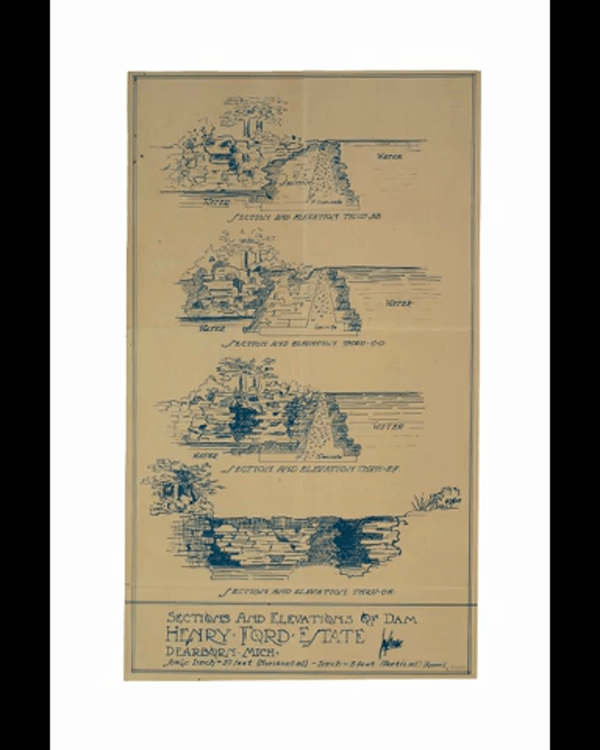
Here is a look at all the prints and the box they’re stored in.
What interesting artifact will we be photographing next? Peek through the Photo Studio’s glass doors at the back of Henry Ford Museum of American Innovation on your next visit and find out!
Continue Reading
21st century, photography, fashion, drawings, digitization, by Jillian Ferraiuolo, #digitization100K, #Behind The Scenes @ The Henry Ford
Tips for the Most Insta-Worthy Pics
The Henry Ford was recently recognized by WXYZ as one of the most Instagrammable spots in metro Detroit. If you’re always striving for that perfect Instagram post, here are a few tips and tricks I’ve learned in the Photography Studio at the Henry Ford Museum of American Innovation.
First, composition is key. Make sure to take a look around you as you compose your shot—what do you want to include? Sometimes an interesting angle, or an object in the foreground, can change your picture drastically. Make sure to walk around a bit before you snap your shot, or take multiples, and see which one you like best.
Take, for instance, this image I took of the water tower. By keeping it in the background, and other things in the foreground, it changes the photo to a view you might not see right away.
Similarly, going for a different angle can make for an interesting photo, especially when it’s something like Thomas Edison’s Menlo Park lab. Most people see its profile while walking by, and don’t look back when they’re exiting, but just seeing it from another perspective makes it look like an entirely different building.
Another thing to keep in mind is lighting, especially if you’re outside in Greenfield Village. On a sunny day, you want to make sure the sun is at your back, and if you’re taking photos of people, make sure it’s not in their eyes. On a gloomy day, always make sure to play around with the saturation and brightness/contrast before you post your picture. These little things can go a long way and can turn the grayest of photos a bit more vibrant!

An overcast day at the Roundhouse can still have a pop of color.
For larger subjects, it comes back to angles. If you’re having a hard time fitting everything in the frame, take a couple steps back, or turn your focus to the details. Sometimes the most interesting photos come from looking at something a little more closely.



And finally, lighting and exposure are important things to take into account when you’re going for the perfect shot. Though cell phones don’t allow as much control over exposure as cameras do, there’s still a lot that can be done. Take, for instance, these photos of the McDonald’s sign over by Lamy’s. By adjusting the exposure, we get a much more dynamic photo.
Hopefully some of these tips will help you out the next time you’re wandering about the museum or village. What’s your favorite place to take photos here at The Henry Ford? Show us! Use #THFPhoto and show off your work.
Jillian Ferraiuolo is Digital Imaging Specialist at The Henry Ford.
Michigan, Dearborn, photography, photographs, Henry Ford Museum, Greenfield Village, by Jillian Ferraiuolo
Resourcefulness in Photography with the Collections
Have you ever wondered how we photograph quilts at The Henry Ford? While the answer is probably no, you might be surprised to find out that it is quite a process. Most quilts are quite large, ranging from 7ft x 4ft to even 9ft x 5ft. With that being said, our photo studio in the museum only has a ceiling that is 10ft tall, but to get an accurate picture of the quilt we would need the camera to be pointing at the quilt at a 90-degree angle. How do we accomplish that in a room that’s only 10 ft tall? We find higher ground!
Since our studio is on the back wall of the museum, we need to be somewhere elevated, but relatively nearby so we aren’t hauling our equipment all over the place. So, the Highland Park Engine is our answer. We mount the camera on the top railing of the stairs closest to the entrance to Conservation.


Then, with the help of 2-3 people, we lay the quilts on a large 10 x 10 wooden board that has a layer of muslin cloth on it (to protect the quilts and stop them from sliding down the board), We hoist the quilt board up onto stands to hold it in place at about a 60-degree angle which allows us to angle the camera to shoot straight at the quilt, giving us the correct perspective as if it were lying flat.
Here are a few examples of the finished images that go online on our Digital Collections website.

Looking at them, you wouldn’t think that they were photographed any other way than lying down, right? That’s the magic of photography - with a little bit of resourcefulness and ingenuity added in.
You can view all the quilts from our collection that we’ve photographed on our Digital Collections here.
Jillian Ferraiuolo is Digital Imaging Specialist at The Henry Ford.
Henry Ford Museum, quilts, photography, digitization, collections care, by Jillian Ferraiuolo, #Behind The Scenes @ The Henry Ford

